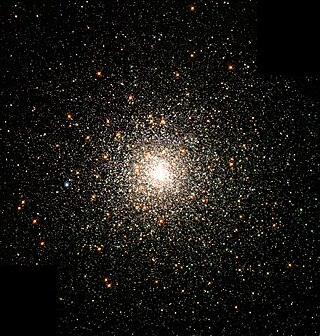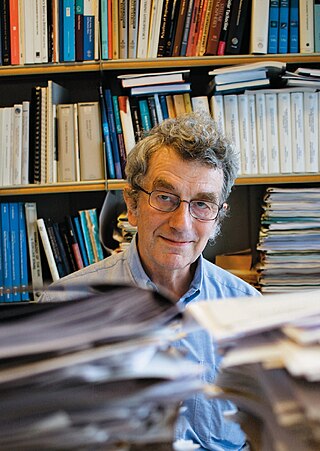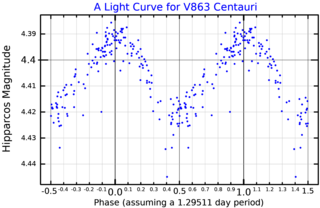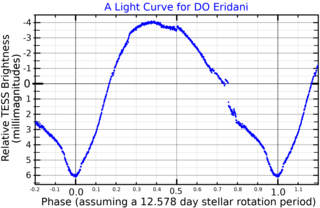Related Research Articles

Mira variables are a class of pulsating stars characterized by very red colours, pulsation periods longer than 100 days, and amplitudes greater than one magnitude in infrared and 2.5 magnitude at visual wavelengths. They are red giants in the very late stages of stellar evolution, on the asymptotic giant branch (AGB), that will expel their outer envelopes as planetary nebulae and become white dwarfs within a few million years.

Asteroseismology is the study of oscillations in stars. Stars have many resonant modes and frequencies, and the path of sound waves passing through a star depends on the speed of sound, which in turn depends on local temperature and chemical composition. Because the resulting oscillation modes are sensitive to different parts of the star, they inform astronomers about the internal structure of the star, which is otherwise not directly possible from overall properties like brightness and surface temperature.
Helioseismology, a term coined by Douglas Gough, is the study of the structure and dynamics of the Sun through its oscillations. These are principally caused by sound waves that are continuously driven and damped by convection near the Sun's surface. It is similar to geoseismology, or asteroseismology, which are respectively the studies of the Earth or stars through their oscillations. While the Sun's oscillations were first detected in the early 1960s, it was only in the mid-1970s that it was realized that the oscillations propagated throughout the Sun and could allow scientists to study the Sun's deep interior. The modern field is separated into global helioseismology, which studies the Sun's resonant modes directly, and local helioseismology, which studies the propagation of the component waves near the Sun's surface.

Maia, designated 20 Tauri, is a star in the constellation of Taurus. It is a blue giant of spectral type B8 III, a chemically peculiar star, and the prototype of the Maia variable class of variable star.

In astronomy, metallicity is the abundance of elements present in an object that are heavier than hydrogen and helium. Most of the normal currently detectable matter in the universe is either hydrogen or helium, and astronomers use the word "metals" as convenient shorthand for "all elements except hydrogen and helium". This word-use is distinct from the conventional chemical or physical definition of a metal as an electrically conducting solid. Stars and nebulae with relatively high abundances of heavier elements are called "metal-rich" in astrophysical terms, even though many of those elements are nonmetals in chemistry.

The red-giant branch (RGB), sometimes called the first giant branch, is the portion of the giant branch before helium ignition occurs in the course of stellar evolution. It is a stage that follows the main sequence for low- to intermediate-mass stars. Red-giant-branch stars have an inert helium core surrounded by a shell of hydrogen fusing via the CNO cycle. They are K- and M-class stars much larger and more luminous than main-sequence stars of the same temperature.

18 Scorpii is a solitary star located at a distance of some 46.1 light-years from the Sun at the northern edge of the Scorpius constellation. It has an apparent visual magnitude of 5.5, which is bright enough to be seen with the naked eye outside of urban areas. The star is drifting further away with a radial velocity of +11.6.

12 Canis Majoris is a variable star located about 707 light years away from the Sun in the southern constellation of Canis Major. It has the variable star designation HK Canis Majoris; 12 Canis Majoris is the Flamsteed designation. This body is just barely visible to the naked eye as a dim, blue-white hued star with a baseline apparent visual magnitude of +6.07. It is moving away from the Earth with a heliocentric radial velocity of +16 km/s. This is the brightest star in the vicinity of the open cluster NGC 2287, although it is probably not a member based on its proper motion.
The standard solar model (SSM) is a mathematical treatment of the Sun as a spherical ball of gas. This model, technically the spherically symmetric quasi-static model of a star, has stellar structure described by several differential equations derived from basic physical principles. The model is constrained by boundary conditions, namely the luminosity, radius, age and composition of the Sun, which are well determined. The age of the Sun cannot be measured directly; one way to estimate it is from the age of the oldest meteorites, and models of the evolution of the Solar System. The composition in the photosphere of the modern-day Sun, by mass, is 74.9% hydrogen and 23.8% helium. All heavier elements, called metals in astronomy, account for less than 2 percent of the mass. The SSM is used to test the validity of stellar evolution theory. In fact, the only way to determine the two free parameters of the stellar evolution model, the helium abundance and the mixing length parameter, are to adjust the SSM to "fit" the observed Sun.
Solar-like oscillations are oscillations in stars that are excited in the same way as those in the Sun, namely by turbulent convection in its outer layers. Stars that show solar-like oscillations are called solar-like oscillators. The oscillations are standing pressure and mixed pressure-gravity modes that are excited over a range in frequency, with the amplitudes roughly following a bell-shaped distribution. Unlike opacity-driven oscillators, all the modes in the frequency range are excited, making the oscillations relatively easy to identify. The surface convection also damps the modes, and each is well-approximated in frequency space by a Lorentzian curve, the width of which corresponds to the lifetime of the mode: the faster it decays, the broader is the Lorentzian. All stars with surface convection zones are expected to show solar-like oscillations, including cool main-sequence stars, subgiants and red giants. Because of the small amplitudes of the oscillations, their study has advanced tremendously thanks to space-based missions.
Rapidly oscillating Ap stars (roAp stars) are a subtype of the Ap star class that exhibit short-timescale rapid photometric or radial velocity variations. The known periods range between 5 and 23 minutes. They lie in the δ Scuti instability strip on the main sequence.

Jørgen Christensen-Dalsgaard is a Danish astronomer at Aarhus University in Denmark. He specializes in asteroseismology and helioseismology. He has made significant contributions to both fields, including predicting the oscillation of Sun-like stars in 1983. He is the head of "Rumudvalget" and the Stellar Astrophysics Centre (SAC) supported by the Danish National Research Foundation. He is co-investigator on the Kepler mission and, with Hans Kjeldsen in Aarhus, leads the 500+ researchers in the Kepler Asteroseismic Science Consortium (KASC). KASC is responsible for the asteroseismology component of the Kepler mission. Christensen-Dalsgaard has published several papers on this subject. He was also previously the president of Commission 27 of the International Astronomical Union.

W Virginis is the prototype W Virginis variable, a subclass of the Cepheid variable stars. It is located in the constellation Virgo, and varies between magnitudes 9.46 and 10.75 over a period of approximately 17 days.

SX Phoenicis is a variable star in the southern constellation Phoenix. With an apparent visual magnitude ranging around 7.33, it is too faint to be readily seen with the naked eye and requires binoculars. It is located 272 light years from the Sun, as determined from an annual parallax shift of 12 mas.

HD 105382 is a star in the constellation Centaurus. Its apparent magnitude is 4.47. From parallax measurements, it is located 130 parsecs from the Sun.

HD 64740 is a single star in the southern constellation Puppis, positioned near the line of sight to the Gum Nebula. It has a blue-white hue and is faintly visible to the naked eye with an apparent visual magnitude of 4.63. Parallax measurements give a distance estimate of approximately 760 light-years from the Sun, and it is drifting further away with a radial velocity of +8 km/s.
Yvonne Elsworth FRS FInstP FRAS is an Irish physicist, Professor of Helioseismology and Poynting Professor of Physics in the School of Physics and Astronomy at the University of Birmingham. Elsworth was until 2015 also the Head of the Birmingham Solar Oscillations Network (BiSON), the longest running helioseismology network with data covering well over three solar cycles.

Xi Phoenicis, Latinized from ξ Phoenicis, is a visual binary star system in the southern constellation of Phoenix. It is faintly visible to the naked eye, having an apparent visual magnitude of 5.70. Based upon an annual parallax shift of 14.61 mas as measured from Earth, it is located around 223 light years from the Sun. The system is moving away from the Sun with a radial velocity of about +10 km/s.

Rho Phoenicis is a variable star in the constellation of Phoenix. From parallax measurements by the Gaia spacecraft, it is located at a distance of 245 light-years from Earth.

HR 1217 is a variable star in the constellation Eridanus. It has the variable star designation DO Eridani, but this seldom appears in the astronomical literature; it is usually called either HR 1217 or HD 24712. At its brightest, HR 1217 has an apparent magnitude of 5.97, making it very faintly visible to the naked eye for an observer with excellent dark-sky conditions.
References
- ↑ GOUGH, Prof. Douglas Owen, Who's Who 2014, A & C Black, 2014; online edn, Oxford University Press, 2014
- ↑ "International Astronomical Union | IAU". www.iau.org.
- ↑ "Douglas Gough | JILA NIST-CU". Archived from the original on 19 April 2012. Retrieved 21 December 2011.
- ↑ "Prof Douglas O Gough | Institute of Astronomy". www.ast.cam.ac.uk.
- ↑ Gough, D. O.; Tayler, R. J. (1966), "The influence of a magnetic field on Schwarzschild's criterion for convective instability in an ideally conducting fluid", MNRAS, 133: 85–98, Bibcode:1966MNRAS.133...85G, doi: 10.1093/mnras/133.1.85
- ↑ Gough, D. O. (1969), "The Anelastic Approximation for Thermal Convection.", Journal of the Atmospheric Sciences, 26 (3): 448–456, Bibcode:1969JAtS...26..448G, doi: 10.1175/1520-0469(1969)026<0448:taaftc>2.0.co;2
- ↑ Gough, D. O. (1977), "Mixing-length theory for pulsating stars", Astrophysical Journal, 214: 196, Bibcode:1977ApJ...214..196G, doi: 10.1086/155244
- ↑ Baker, N. H.; Gough, D. O. (1979), "Pulsations of model RR Lyrae stars", Astrophysical Journal, 232: 224–244, Bibcode:1979ApJ...234..232B, doi: 10.1086/157492
- ↑ Balmforth, N. J. (1992), "Solar pulsational stability - I. Pulsation-mode thermodynamics", MNRAS, 255 (4): 603–649, Bibcode:1992MNRAS.255..603B, doi: 10.1093/mnras/255.4.603
- ↑ Christensen-Dalsgaard, J.; Gough, D. O. (1976), "Towards a heliological inverse problem", Nature, 259 (5539): 89–92, Bibcode:1976Natur.259...89C, doi:10.1038/259089a0, S2CID 10540902
- ↑ Gough, D. O. (1996), "Astereoasteroseismology", The Observatory, 116: 313–315, Bibcode:1996Obs...116..313G
- ↑ Christensen-Dalsgaard, J.; Gough, D. O.; Thompson, M. J. (1991), "The depth of the solar convection zone" (PDF), Astrophysical Journal, 378: 413, Bibcode:1991ApJ...378..413C, doi:10.1086/170441
- ↑ Duvall, Jr. T. L.; Dziembowski, W. A.; Goode, P. R.; Gough, D. O.; Harvey, J. W.; Leibacher, J. W. (1984), "Internal rotation of the sun", Nature, 310 (5972): 22–25, Bibcode:1984Natur.310...22D, doi:10.1038/310022a0, S2CID 4310140
- ↑ Gough, D. O. (1983), "The protosolar helium abundance", Primordial Helium, ed. P.A. Shaver, D. Kunth & K. Kjaer, European Southern Observatory: 117–136, Bibcode:1983prhe.work..117G
- ↑ Houdek, G.; Gough, D. O. (2011), "On the seismic age and heavy-element abundance of the Sun", MNRAS, 418 (2): 1217–1230, arXiv: 1108.0802 , Bibcode:2011MNRAS.418.1217H, doi: 10.1111/j.1365-2966.2011.19572.x
- ↑ Gough, D. O. (1990), "Comments on helioseismic inference", Progress of Seismology of the Sun and Stars, Lecture Notes in Physics, 267: 283–318, Bibcode:1990LNP...367..283G, doi:10.1007/3-540-53091-6, ISBN 978-3-540-53091-6
- ↑ Houdek, G.; Gough, D. O. (2007), "An asteroseismic signature of helium ionization", MNRAS, 375 (3): 861–880, arXiv: astro-ph/0612030 , Bibcode:2007MNRAS.375..861H, doi: 10.1111/j.1365-2966.2006.11325.x
- ↑ "SolarNews August 1994". August 1994.
- ↑ "Previous winners of the George Ellery Hale Prize". Archived from the original on 13 August 2013. Retrieved 22 November 2016.
- ↑ "News: Society for the History of Astronomy; short-term contract information sought; more asteroids than ever; state of the union; Society medals for Jacobs Mestel and Gough; RAS grants announcement; spidermen; new faces for the Planetary Forum; an RAS Council member.", Astronomy and Geophysics, 43 (3): c4, 2002, Bibcode:2002A&G....43c...4., doi: 10.1046/j.1468-4004.2002.43304.x
- ↑ "Awards: RAS Awards 2010; Prof. John Woodhouse; Prof. Douglas Gough; Prof. Bernard Roberts; Prof. James Hough; Dr Ineke De Moortel; Dr Barbara Ercolano", Astronomy and Geophysics, 51 (1): a37, 2010, Bibcode:2010A&G....51a..37., doi: 10.1111/j.1468-4004.2010.51137.x
- ↑ Crafoord Prize 2024